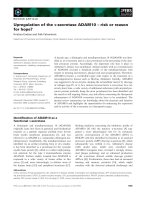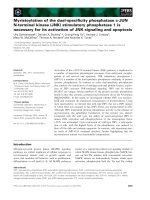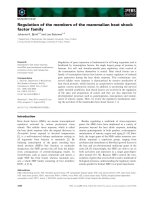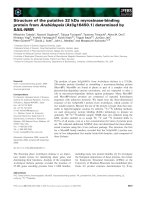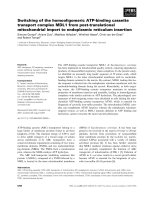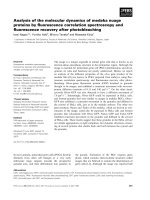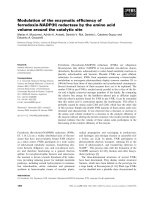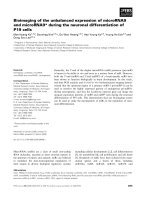Báo cáo khoa học: Inhibition of the D-alanine:D-alanyl carrier protein ligase from Bacillus subtilis increases the bacterium’s susceptibility to antibiotics that target the cell wall potx
Bạn đang xem bản rút gọn của tài liệu. Xem và tải ngay bản đầy đủ của tài liệu tại đây (325.29 KB, 11 trang )
Inhibition of the D-alanine:D-alanyl carrier protein ligase
from Bacillus subtilis increases the bacterium’s
susceptibility to antibiotics that target the cell wall
Juergen J. May*, Robert Finking*
,
†, Frank Wiegeshoff, Thomas T. Weber, Nina Bandur,
Ulrich Koert and Mohamed A. Marahiel
Philipps-Universita
¨
t Marburg, Fachbereich Chemie ⁄ Biochemie, Marburg, Germany
The cell wall of most Gram-positive bacteria is com-
posed of a thick peptidoglycan fabric containing, in
general, two types of anionic polymers: the lipoteichoic
acid (LTA) and wall teichoic acid (WTA) which are in
most cases modified with a d-alanyl ester or a glycosyl
residue [1,2].
In Bacillus subtilis, and several other Gram-positive
bacteria such as Staphylococcus aureus, the dlt operon
is responsible for the d-alanylation of lipoteichoic and
wall teichoic acid [3,4]. Three functions of the d-alan-
ylated LTA have been proposed: (a) modulation of the
activity of autolysins; (b) maintenance of cation homeo-
stasis and assistance in the assimilation of metal cati-
ons for cellular functions; and (c) definition of the
electrochemical properties of the cell wall [5].
The dlt operon seems to be widespread among
Gram-positive bacteria and comprises five ORFs enco-
ding the proteins named DltA–E [1,3,4,6] (Fig. 1).
DltA is a distinct protein with a molecular mass
of 57 kDa that resembles adenylation domains
(A-domains) of nonribosomal peptide synthetases
(NRPS). Just as for a classic A-domain, DltA was
Keywords
D-alanyl ligase; DltA; DltC; antibiotics that
target the cell wall; DltA inhibitor
Correspondence
M. A. Marahiel, Philipps-Universita
¨
t
Marburg, Fachbereich Chemie ⁄ Biochemie,
Hans-Meerwein-Strasse, D-35032 Marburg,
Germany
Fax: +49 6421 2822191
Tel: +49 6421 2825722
E-mail:
*These authors contributed equally to this
work
†Present address
University of Cologne, Institute for Genetics,
Zu
¨
lpicher Str. 47, 50674 Cologne, Germany
(Received 24 February 2005, revised 26
March 2005, accepted 4 April 2005)
doi:10.1111/j.1742-4658.2005.04700.x
The surface charge as well as the electrochemical properties and ligand
binding abilities of the Gram-positive cell wall is controlled by the
d-alanylation of the lipoteichoic acid. The incorporation of d-Ala into
lipoteichoic acid requires the d-alanine:d-alanyl carrier protein ligase
(DltA) and the carrier protein (DltC). We have heterologously expressed,
purified, and assayed the substrate selectivity of the recombinant proteins
DltA with its substrate DltC. We found that apo-DltC is recognized by
both endogenous 4¢-phosphopantetheinyl transferases AcpS and Sfp. After
the biochemical characterization of DltA and DltC, we designed an inhib-
itor (d-alanylacyl-sulfamoyl-adenosine), which is able to block the d-Ala
adenylation by DltA at a K
i
value of 232 nm in vitro. We also performed
in vivo studies and determined a significant inhibition of growth for differ-
ent Bacillus subtilis strains when the inhibitor is used in combination with
vancomycin.
Abbreviations
aaRS, amino-acyl-tRNA-synthetases; AcpS, acyl carrier protein phosphopantetheintransferase; CP, carrier protein;
D-aa, D-configured amino
acids;
D-Abu, D-aminobutyric acid; L-aa, L-configured amino acids; LTA, lipoteichoic acid; NRPS, nonribosomal peptide synthetases; PPTases,
phosphopantetheintransferase; Sfp, peptidyl carrier protein phosphopanthetheintransferase; WTA, wall teichoic acid.
FEBS Journal 272 (2005) 2993–3003 ª 2005 FEBS 2993
thought to specifically select its cognate amino acid,
d-Ala, and to activate it as the corresponding amino-
acyl-adenylate [3]. Usually in NRPS systems, l-amino
acids (l-aa) or carboxy acids are activated and some-
times racemized by modular proteins that comprises
epimerization ⁄ racemization domains (E-domain) for
subsequent conversion in the corresponding d-form.
Also, some cases A-domains accept both enantiomers
still having the E-domain but only few d-amino acids
(d-aa) activating A-domains are known and none are
fully biochemical characterized. The open reading
frame dLtC encodes the corresponding d-Ala carrier
protein (DltC), which subsequently picks up the activa-
ted d-Ala with the enzyme bound cofactor 4¢-phospho-
pantetheine that binds the amino acid covalently as
thioester [7,8] (Fig. 1). In this state, DltC donates
d-Ala to LTA, presumably with the help of DltB.
After having reached its target location, d-Ala is incor-
porated into LTA by action of DltD [5,6,9] (Fig. 1).
This protein possesses a membrane anchor and has
been proposed to link d-Ala with LTA or WTA [9].
As a consequence, LTA and WTA is almost com-
pletely alanylated, which reduces or eliminates the neg-
ative surface charge of the bacterial membrane.
Reductions in the d-alanyl content of the cell wall
influences directly the autolysis mechanism [2,10,11]
and renders bacteria sensitive to so-called host defense
peptides as well as other intrinsic antibiotic substances
[4]. In addition, the ability of Gram-positive bacteria
to produce biofilms is abolished [12,13].
Despite the fact that d-alanylation is not necessary
for viability and thus at first sight seems to be dispen-
sable, various mutants exhibit a wide array of pharma-
cological phenotypes. Insertional inactivation of the dlt
operon in Staphylococcus aureus and Staphylococcus
xylosus leads to enhanced susceptibility of cells to posi-
tively charged antimicrobial peptides. In case of
Staphylococcus aureus, it was shown that the bacterium
can be efficiently killed by human neutrophils and is
no longer able to successfully infect mice in contrast to
wild type [14]. A clear correlation between the d-alany-
lation of LTA and virulence has been established
recently also for Streptococcus agalactiae and Listeria
monocygotes [15–17]. In Bacillus subtilis, insertional
inactivation of the genes of the dlt operon results in an
increased rate of autolysis but the strain shows no
aberrant morphology, cell growth or basic metabolism
[11]. Lactobacillus rhamnosus, on the other hand,
exhibits additional defects in cell separation during
proliferation. Thus, the d-alanyl esters of LTA appear
to play a variety of roles in Gram-positive organisms,
which prompted us to design an inhibitor to specific-
ally restrain the d-alanylation of the WTA and LTA
in Gram-positive bacteria.
The pharmacological relevance of the dlt operon
seems obvious in light of these findings; a total
Fig. 1. D-Ala-biosynthesis gene clusters
from B. subtilis and their corresponding
domain organization of NRPS-like proteins.
(A) Genes are depicted as arrows, proteins
as circles. The numbers indicate the aa of
the corresponding protein. (B) Reaction
catalysed by the proteins DltA and DltC.
A, Adenylation domain; CP, carrier protein;
Ato, alditol; P, phosphate; DltA–E: proteins
involved.
Characterization and inhibition of the Dlt system J. J. May et al.
2994 FEBS Journal 272 (2005) 2993–3003 ª 2005 FEBS
restriction on the synthesis of biofilms as well as the
increased sensitivity to cationic antibiotics and a
decrease in virulence would aid in the successful treat-
ment of pathogenic bacteria either with the inhibitor
alone or in combination with common antibiotics.
Recent results extracted from two crystal structures of
NRPS-A-domains, PheA [18] and DhbE [19] yielded
deep insight into the reaction mechanism for the activa-
tion of amino-acid substrates as their corresponding
adenylate and demonstrated the high functional analogy
of the reaction to amino-acyl-tRNA-synthetases (aaRS)
[20]. Despite the fact that these proteins are structurally
unrelated [20] the functional analogy inspired us to
design an inhibitor, which should efficiently block
the aminoacyl adenylation step catalyzed by DltA. The
design of the inhibitor was encouraged by the known
inhibitors of aaRS [21–25]. These inhibitors were
5¢-O-[N-(aminoacyl)-sulfamoyl] adenosine molecules
which are nonhydrolysable analogues of amino acyl
adenylates. The concept of these inhibitors was adapted
to the NRPS-system to inhibit the A-domains PheA and
LeuA [26]. In the following work, we describe the clo-
ning and purification of the two proteins DltA and DltC
from B. subtilis as well as their biochemical characteri-
zation. We have characterized and tested a synthesized
d-Ala sulfamoyl adenylate analog in vitro and in vivo
and show the efficiency of this molecule in blocking
DltA activity in vitro and in vivo.
Results
Overproduction and purification of DltA and DltC
Both proteins were produced as C-terminal His
6
tag
fusion proteins and purified by Ni
2+
⁄ nitrilotriacetic
acid-affinity chromatography followed by gel filtration.
SDS ⁄ PAGE analysis (not shown) revealed two bands
(monomer and putative dimer) in the case of DltC.
These two states of the protein result from partial apo-
to holo conversion (about 51% holo-form as judged
from HPLC analysis) by an E. coli PPTase and prob-
ably subsequent dimerization via disulfide bridges as
previously reported [8]. DltA and DltC were obtained
with a purity > 99% with 20 and 30 mgÆL
)1
of cell
culture, respectively.
Post-translational modification of DltC
by AcpS and Sfp
The prerequisite for the enzymatic action of DltA on
its natural protein partner, DltC, is the modification of
this carrier protein (CP) to the active holo-form. To
assess the affiliation of DltC with primary or secon-
dary metabolism of B. subtilis, kinetics of the modifica-
tion with both PPTases (AcpS, the PPTase of primary
metabolism and Sfp, the PPTase of secondary metabo-
lism) were measured. For this purpose, an HPLC assay
was carried out. The ratio of apo- to holo-DltC after
heterologous production in E. coli was 48.5–51.5%.
For the determination of kinetic constants, the apo-
DltC concentration was varied while the CoA concen-
tration was kept constant. Kinetic constants were
determined through a Michaelis–Menten fit of the data
sets (Fig. 2). In the case of AcpS, the K
m
value for
apo-DltC concentrations between 1 and 76 lm was
8.73 ± 0.73 lm with a k
cat
of 169 ± 4 min
)1
. Kinetic
constants for Sfp with the apo-DltC concentration ran-
ging from 1 to 102 lm were K
m
¼ 50.40 ± 5.3 and
k
cat
¼ 287 ± 16 min
)1
. The resulting catalytic efficien-
cies for these reactions are 3.23 · 10
5
m
)1
Æs
)1
and
9.94 · 10
4
m
)1
Æs
)1
for AcpS and Sfp, respectively.
Thus, although the K
m
of Sfp is almost six times as
0 20 40 60 80 100 120
0
20
40
60
80
100
120
140
160
180
200
k
cat
287 ± 16 min
-1
K
M
50.4 ± 5.3 µM
V [1/min]
[DCP] [µM]
0 20 40 60 80 100 120 140 160
0
20
40
60
80
100
120
140
160
A
B
V [1/min]
[DCP] [µM]
k
cat
169.5 ± 4.6 min
-1
K
M
17.14 ± 1.5 µM
Fig. 2. Determination of kinetic constants of B. subtilis Sfp and
Acps with apo-DltC as substrate. (A) Reaction mixtures were incu-
bated for 10 min (5.6 n
M AcpS) and 30 min (11 nM Sfp). A hyper-
bolic Michaelis–Menten function was used to fit the kinetic data.
The kinetic constants toward the carrier proteins are indicated. (B)
Plot of velocity of AcpS against apo-DltC concentration between 1
and 150 l
M. Kinetic data for Sfp with apo-DltC-concentrations
between 1 and 102 l
M.
J. J. May et al. Characterization and inhibition of the Dlt system
FEBS Journal 272 (2005) 2993–3003 ª 2005 FEBS 2995
high as that of AcpS, the catalytic efficiency is only
diminished by a factor of 3.4 making the assignment
of DltC to primary or secondary metabolism difficult.
This is the first time that AcpS as well as Sfp exhibit a
similar catalytic efficiency with the same CP.
Substrate specificity and biochemical
characterization of DltA
The substrate selectivity of DltA toward all proteino-
genic amino acids in addition to d-Ala and several
other d-amino acids was determined. Until now, no
d-aa activating A-domain had been characterized. All
A-domains described so far are unable to activate
solely a d-aa but activate carboxy acids or l-aa, which
are subsequently racemized to their corresponding
d-enantiomer with the help of an E-domain. As
deduced from the protein product and the selectivity
conferring residues of the active site [33], DltA activa-
ted solely d-Ala with a slight side-specificity for d-Abu
(Fig. 3). The K
m
value of DltA for d-Ala was subse-
quently determined by varying the d-Ala concentration
between 1 and 1000 lm. The resulting K
m
of
13.62 ± 4.18 lm (Fig. 3) is well in the range of the K
m
of other A-domains for their cognate l-aa [35–37].
Modification of DltC and ACP by DltA
Holo-DltC is the natural protein partner of DltA.
Nevertheless, it was shown for Lactobacillus rhamnosus
that the holo-ACP of fatty acid synthase is also
modified by DltA [9]. To assay this finding, the con-
centration of d-Ala was kept constant while the con-
centration of the CPs was varied. DltA exhibits a K
m
of 8.04 ± 1.73 lm and a k
cat
of 48949 ± 5983Æmin
)1
for holo-DltC concentrations between 0.12 and
10.05 lm. However, this reaction suffers from severe
substrate inhibition if the holo-DltC concentration is
raised above 15 lm. Nevertheless, the k
cat
⁄ K
m
of this
reaction with a value of 1.01 · 10
8
m
)1
Æs
)1
demon-
strates that the reaction is in fact only limited by diffu-
sion. The situation is quite different with ACP of fatty
acid synthase, which was not expected to be a natural
substrate of DltA. A qualitative assay showed that
DltA does indeed modify ACP but our attempt to
determine the catalytic constants of this reaction failed.
Not only was the amount of ACP needed to reach sat-
isfactory values of modification about three times as
high as in the case of DltC, saturation was not reached
even at 120 lm holo-ACP. The apparent K
m
deter-
mined in this way lies in the mm range, which indicates
that ACP is modified in vivo to a significantly lesser
extend than is DltC.
Inhibition of DltA by 5¢-O-[N-(
D-alanyl)-
sulfamoyl]adenosine (5) in vitro and its effect
on cell growth
To test the quality of inhibition by 5, the K
i
was deter-
mined. For this purpose, the concentration of 5 was
varied while the concentration of the substrate amino
acid, d-Ala, was held constant. Three different sets of
data points were collected for three different concen-
trations of d-Ala, namely 0.5, 1 and 2 K
m
. The concen-
tration of the inhibitor was plotted against the 1 ⁄ cpm
from the ATP ⁄ PP
i
exchange assays in Dixon plots [38]
(Fig. 4). The intersect of the three straight lines yields
a K
i
of 232 nm which is almost 60-fold lower than the
0
50K
100K
150K
200K
250K
neg.
beta Ala
Sarcosin
L-Ala
L-Arg
L-Gly
L-Pro
L-Asn
L-Gln
L-Phe
L-Asp
D-Glu
D-Trp
D-Abu
D-Asp
D-Pro
D-Val
D-Phe
D-Leu
D-Cys
D-Tyr
D-Orn
D-Allo-Ile
D-Ala
0 200 400 600 800 1000
0
20K
40K
60K
80K
100K
120K
140K
160K
180K
200K
K
M
=13.6 ± 4.1
CPM
[d-Ala] [µM]
Fig. 3. Amino-acid-dependent ATP ⁄ PPi
exchange for DltA. To determine the sub-
strate selectivity of DltA, assays were
performed with all 20 proteinogenic amino
acids in addition to several
D-aa and sarco-
sin. Only some representative amino acids
and the substrate acids
D-Ala and D-Abu are
shown. The highest activity was set to
100%; in this case, it corresponds to 36 m
M
label exchanged by 500 nM DltA with
0.5 m
MD-Ala in 5 min. Inset: kinetic deter-
mination of the K
m
and k
cat
values.
Characterization and inhibition of the Dlt system J. J. May et al.
2996 FEBS Journal 272 (2005) 2993–3003 ª 2005 FEBS
K
m
value of DltA for d-Ala and makes 5 suitable as
an inhibitor.
To test if the inhibitor 5 was able to penetrate the
cell wall to reach its target DltA, we investigated chan-
ges in the growth rates of the Gram positive wild
type strains B. subtilis JH642 and the the B. subtilis
DltA-deletion mutant. This DltA-mutant was used to
exclude the possibility that 5 may act as an inhibitor
in pathways other than that of DltA. We also test the
susceptibility of these strains to a combination of 5
and vancomycin and observed as shown in Fig. 5 a
total growth inhibition of wild type strain when vanco-
mycin and 5 were used, whereas treatment of wild type
cells (B. subtilis JH642) with vancomycin alone without
5 shows after an initial cell inhibition a total recovery
of cell growth after 10 h. No such a recovery after
30 h was observed for the DltA mutant when 5 and
vancomycin were used simultaneously (Fig. 5).
Discussion
The biosynthesis of d-alanyl-lipoteichoic acid requires
four proteins that are encoded by the dlt operon [5].
The synthesis starts with the selection of the d-Ala
by the 57 kDa d-Ala-d-Ala carrier protein ligase
(DltA). Following activation by DltA, d-Ala is trans-
ferred to the 10 kDa d-alanyl carrier protein DltC
which can donate d-Ala to lipoteichoic acids with the
help of DltB and DltD to mediate the surface charge
of the bacterium (Fig. 1). We have cloned the first
two proteins (DltA and DltC) that are involved in
the d-alanylation of the Gram-positive cell wall. Pro-
duction of the proteins in E. coli works well and the
two proteins catalyzes the expected reactions. DltA
selectively activates d-Ala with only slight side speci-
ficity for the nonproteinogenic amino acid d-Abu
(Fig. 3). This is remarkable, as until now no
A-domain with a d-aa as the sole substrate has been
biochemically characterized. Especially the fact that
the enzyme does not activate l-Ala corroborates the
finding that A-domains as well as aaRS discriminate
not only against different amino acid but also against
enantiomers [39]. Determination of the substrate
selectivity of A-domains can either be accomplished
by ATP ⁄ PP
i
exchange assays or by analysis of the
selectivity-conferring residues guided by the nonribo-
somal code of NRPS A-domains [19,33]. Both studies
led independently to the determination of d-Ala
selectivity for DltA, further substantiating the
nonribosomal code. Because Gram-positive bacteria
-300 -200-200 -100 00 100 200200 300 400400
-6
-6
1,2x10
-5
1,6x10
-5
2,0x10
-5
2,4x10
-5
K
M
/2
K
M
2 K
M
1/V [1/CPM]
[I] [nM]
8,0x10
4,0x10
Fig. 4. Dixon plot of inhibition studies with DltA and 5. The concen-
tration of the inhibitors was varied as follows: 50, 100, 200, 300
and 400 n
M. The D-Ala concentration was as indicated in the plot.
0.01
0.1
1
10
Time (h)
D
600
0.01
0.1
1
10
Time (h)
D
600
JH642∆DltA +V/+I JH642∆DltA +V/-I JH642∆DltA -V/-I
010
5
15 20 25 30
010
5
15 20 25 3
0
JH642+V/+I JH642 +V/-I JH642 -V/-I
A
B
Fig. 5. Growth inhibition of B. subtilis JH642 (A) and B. subtilis
JH642DdltA (B) using vancomycin and the inhibitor 5. The presence
(+) and absence (–) of 5 (I) and vancomycin (V) are indicated and
the concentrations used are 5 at 1 m
M and vancomycin at 0.4 nM.
Squares: without vancomycin and 5; diamonds with vancomycin;
circles with vancomycin and 5.
J. J. May et al. Characterization and inhibition of the Dlt system
FEBS Journal 272 (2005) 2993–3003 ª 2005 FEBS 2997
have evolved an A-domain specific for a d-aa, no
additional modifying enzyme such as an E-domain is
needed to process the adenylate product, which shows
the close affiliation of the dlt operon with primary
metabolism. Sequence identity of DltC with ACP as
well as PCPs is low (17.9% and 2.6–6.8%, respect-
ively) but because percentage of homology is closer
to ACP, we take this as another hint for association
with primary metabolism. Because the dlt operon is
not essential for viability, we decided to determine
the Michaelis constants for the phosphopantetheinyla-
tion of DltC by the PPTases of primary metabolism,
namely AcpS, and secondary metabolism, Sfp. Sur-
prisingly we found that the k
cat
values are in the
same range for both PPTases whereas, in other cases,
discrimination between protein substrates by PPTases
is often reflected by these values [32,34,40]. K
m
values
and catalytic efficiency of Sfp, however, are dimin-
ished by a factor of 5.8 and 30.8, respectively, com-
pared to those determined for AcpS, which is another
hint for the fact that DltC is indeed part of primary
metabolism. In addition, the K
m
value of AcpS with
DltC compared to that with ACP [32] is almost eight-
fold lower. Although we have not determined the
abundance of DltC in B. subtilis, ACP is known to
be one of the most abundant proteins [41], which ren-
ders a low K
m
unnecessary. In the case of DltC, how-
ever, the K
m
indicates that it is preferred over ACP
so that B. subtilis can sustain this pathway even if the
amount of DltC was comparatively low.
The fact that DltC was shown to be the cognate
protein substrate of DltA in other organisms [3,7–9] is
in agreement with our findings in B. subtilis. DltA
transfers activated d-Ala to DltC with very high effi-
ciency (Fig. 2). However, the ACP of fatty acid syn-
thase is also aminoacylated [6,42] but an attempt to
determine the Michaelis constant failed because satura-
tion could not be reached (data not shown). In addi-
tion, DltD was shown to exhibit thioesterase activity
toward d-alanylated ACP [9] which indicates that
loading of ACP by DltA in our in vitro assay is an
undesired side reaction.
Mutants in several strains defective in DltA produc-
tion underline the pharmacological relevance of this
system. Blocking of the d-alanylation of the cell wall
leads in many pathogenic bacteria to a higher suscepti-
bility to cationic antibiotics and host defensins, abol-
ishes biofilm production and reduces pathogenicity of
these bacteria [4,12–16,43]. Therefore, we have synthes-
ized 5 (Scheme 1), which shows the expected inhibitory
effect on DltA in vitro. The K
i
(232 nm, Fig. 4) is well
in the range of NRPS A-domain inhibitors [26] and
inhibitors of aaRS [23,24]. In addition, the Phe activa-
ting A-domain GrsA-A [18, 44] and the carboxy acid
activating A-domain DhbE [19] remain unaffected by 5
up to a concentration of 2 mm (data not shown), which
shows the specificity expected of this inhibitor. Also,
comparison of the K
i
with the K
m
of DltA with d-Ala
(13.62 lm; Fig. 3), shows that the K
i
is 60-fold lower
which corroborates the suitability of 5 as an inhibitor.
Ascamycin is the 2-chloro-l-Ala-sulfamoyl adeny-
late analog of 5 (Fig. 6). This substance is a nucleo-
side antibiotic found in the fermentation broth of
Streptomyces [45]. It was therefore conceivable that,
O
OO
N
N
N
NH
2
HO
O
S
O
H
2
NCl
1) NaH, THF, 55°C
2)
0°C
O
OO
N
N
N
NH
2
O
S
H
2
N
O
O
Boc-
D
-Ala-OSu
DBU, DMF
O
OO
N
N
N
NH
2
O
S
N
H
O
O
O
H
N
Boc
O
HO OH
N
N
N
NH
2
O
S
N
H
O
O
O
H
2
N
2TFA
TFA/H
2
O
1
2
3
4
5
N N
NN
Scheme 1. Synthesis of 5¢-O-[N-(D-alaninyl)sulfamoyl]adenosinÆ2TFA (5). For details see Experimental procedures.
Characterization and inhibition of the Dlt system J. J. May et al.
2998 FEBS Journal 272 (2005) 2993–3003 ª 2005 FEBS
at least to some extent, 5 would be capable of pass-
ing the cell wall, rendering it useful for in vivo inhibi-
tion studies.
If the inhibitor reached its target within the cell, the
phenotype of a wild type strain should be similar to
that of a DltA deletion mutant. Our results shown in
Fig. 5 support this assumption. Phenotypes of several
bacterial strains with altered d-Ala content of the cell
wall have been reported in the past. S. aureus, for
instance, exhibits aberrant cell morphology and an
increased susceptibility to the peptide antibiotic vanco-
mycin [14] and other cationic antibiotics [46] as well as
an impaired virulence [16]. B. subtilis has been shown
to be more vulnerable toward endogenous lytic
enzymes (autolysis) and b-lactam antibiotics [10,11].
Our in vivo studies on inhibition of DltA in wild type
B. subtilis using 5 confirm these earlier results. As can
be seen in Fig. 5, the wild type B. subtilis JH642 shows
the predicted growth behavior, similar to the dltA
mutant. No growth is observed in both strains after
30 h during treatment with 5 and vancomycin. In the
presence of vancomycin and in absence of 5, the wild
type recovers growth after 12 h incubation and, after
30 h, reaches an attenuance comparable to that of
untreated wild type cells.
In light of these results it is tempting to speculate
that all other phenotypes described for mutants of
dLtA [5] could be induced by addition of the inhibitor.
Especially the lowered pathogenicity and the vulnerab-
ility to host defensins observed in dLtA mutants of
pathogenic strains [4,14,15,17,47,48] are of outstanding
pharmacological interest. Also, the fact that the tar-
geted DltA seems to have no protein counterpart in
the human body makes 5 a promising scaffold for
developing a drug candidate with pharmacological
relevance to boost the effectiveness of antibiotics such
as vancomycin.
Experimental procedures
Synthesis of 5¢-O-[N-(D-alanyl)-sulfamoyl]-
adenosineÆ2TFA (5)
5¢-O-[N-(d-Alanyl)-sulfamoyl]-adenosineÆ2TFA was synthes-
ized as shown in Scheme 1.
2¢,3¢-O-Isopropyliden-5¢-O-sulfamoyl-adenosine (3)
Two grams (6.53 mmol) 2¢,3¢-O-isopropyliden-adenosine (1)
were added in four portions to a suspension of 1.045 g
(26.12 mmol) sodium hydride (60%, v ⁄ v, in mineral oil) in
100 mL tetrahydrofuran (THF) under argon atmosphere.
After stirring for 75 min at 55 °C, the mixture was cooled
to 0 °C. A solution of 289 mg (2.5 mmol) sulfamoyl chlo-
ride (2), prepared as described previously [27], in 15 mL
THF was added dropwise within 30 min, while the tem-
perature was maintained at 1–3 °C. The mixture was stirred
for an additional 3 h at 0 °C and the reaction was termin-
ated by the addition of 7 mL methanol. The solvents were
removed in vacuo and the residue was dissolved in water,
adsorbed on silica and purified by flash-column chro-
matography (CHCl
3
⁄ MeOH, 9 : 1, v ⁄ v) to give 1.741 g
(4.51 mmol, 86%) of sufamoyl-adenosine (3) as a colorless
foam.
1
H-NMR (200 MHz, DMSO-d
6
): 8.22 (s, 1H), 8.08
(s, 1H), 7.53 (s, br, 2H), 7.31 (s, br, 2H), 6.22 (d, J ¼
2.4 Hz, 1H), 5.42 (dd, J ¼ 6.3, 2.4 Hz, 1H), 5.07 (dd, J ¼
6.3, 3.0 Hz, 1H), 4.44–4.33 (m, 1H), 4.28–4.03 (m, 1H),
1.54 (s, 3H), 1.33 (s, 3H). MS (ESI): 387 (M + H
+
).
2¢,3¢-O-Isopropylidene-5¢-O-[N-(N-tert-butoxycarbonyl-
D-alanyl)-sulfamoyl]-adenosine (4)
A solution of 182 mg (0.63 mmol) Boc-d-Ala-OSu in
0.5 mL dimethylformamide (DMF) was added within
30 min to a solution of 245 mg (0.63 mmol) 2,3-O-isopro-
pyliden-5¢-O-sulfamoyl-adenosine (3) and 97 lL (0.63 mmol)
1,8 diazobicyclo (5.4.0) undec-7-en (DBU) in 4 mL DMF.
The mixture was stirred for 3 h at room temperature before
the organic solvent was removed in vacuo. The residue was
taken up in 20 mL water and extracted four times with a
total of 125 mL CHCl
3
and once with 25 mL of CHCl
3
⁄
iPrOH, 5 : 1 (v ⁄ v). The organic layers were combined,
washed with 20 mL of a saturated aqueous NaCl solution
and dried with Na
2
SO
4
. Removal of the solvents in vacuo
and purification by flash-column chromatography (CHCl
3
⁄
MeOH ⁄ iPrOH, 8 : 1 : 1, v ⁄ v ⁄ v) gave 260 mg (0.47 mmol,
74%) of sulfamoyl-adenosine (4) as a colorless solid. MS
(ESI): 558 (M + H
+
).
O
HO OH
N
N
N
N
O
NH
2
S
H
N
O
O
O
H
2
N
DltA inhibitor
Ascamycin
O
HO OH
N
N
N
N
O
NH
2
S
H
N
O
O
O
H
2
N
Cl
Fig. 6. Chemical structure of the DltA inhibitor and ascamycin.
J. J. May et al. Characterization and inhibition of the Dlt system
FEBS Journal 272 (2005) 2993–3003 ª 2005 FEBS 2999
5¢-O-[N-(D-Alanyl)-sulfamoyl]-adenosineÆ2TFA (5)
Protected adenosinesulfonamide 4 (116 mg; 0.30 mmol) was
dissolved in 3.5 mL water and 3.5 mL TFA were added.
The mixture was stirred at room temperature for 3 h. After
evaporation of the solvents in vacuo the crude product was
purified by HPLC. The solution was purified using HPLC
(Amersham ⁄ Pharmacia Aekta purifier, Uppsala, Sweden),
Nucleodur column (Macherey and Nagel, Du
¨
ren, Germany)
and monitored at 214 and 247 nm. The following gradient
profile was used at a flow rate of 6 mLÆ min
)1
, applying the
sample at 5% (v ⁄ v) buffer B and performing a two step
gradient. The first step was, after washing the column with
one column volume (19.36 mL), from 5 to 25% buffer A in
seven column volumes followed by the second step to
100% buffer B in one column volume [buffer A, 0.1%
(v ⁄ v) TFA in H
2
O; buffer B, 0.1% (v ⁄ v) TFA in aceto-
nitrile] to give after several runs 134 mg (0.27 mmol) of
pure deprotected adenosinesulfonamide (5). Subsequently
the peaks were verified by mass spectrometry on a Hewlett
Packard 1100 Series machine.
After pooling the collected peaks the solution was freeze
dried and resuspended in water given a concentration of
100 mm (5).
Growth conditions
E. coli was grown on Luria–Bertani medium. Antibiotics
were used at the following concentrations, ampicillin
100 lgÆmL
)1
, kanamycin 25 lgÆmL
)1
. For E. coli tech-
niques, such as transformation and plasmid preparation,
standard protocols were used [28]. Vent polymerase (New
England Biolabs, Schwalbach, Germany) or Pwo poly-
merase (Roche, Mannheim, Germany) was used to amplify
gene fragments for cloning and expression purposes. Oligo-
nucleotides were purchased from Qiagen-Operon (Cologne,
Germany). All resulting clones were sequenced twice on
an ABI prism sequencer according to the manufacturer’s
protocol.
Construction of deletion strain JH642 DdltA
The B. subtilis dLtA deletion strain was constructed by the
method described by [29]. The 5¢ and 3¢ flanking regions of
the dltA gene were PCR amplified using the primer pairs
dLtA-P1 ⁄ dLtA-P2 and dLtA-P3 ⁄ dLtA-P4, respectively. The
primers dLtA-P2 and dLtA-P3 contain complementary
sequences to the ends of the kanamycin resistance cassette
of the plasmid pDG783 [30]. The 5¢ and 3¢ flanking regions
and the kanamycin cassette were combined in a second
PCR with successive amplification of a 3435 bp fragment
after addition of primers dLtA-P1 and dLtA-P4. B. subtilis
strain JH642 was transformed with the PCR fragment,
carrying the kanamycin resistance cassette between the
flanking regions, resulting in JH642 DdltA. Successful
integration of the kanamycin resistency cassette was con-
firmed by PCR.
dLtA-P1, 5¢-ACAAATATAGACACCGAGCAAAATGG
CAA; dLtA-P2, 5¢-
CGAGCTCGAATTCGTAATCATGGT
CATATTATAAATATATGAACCGCTATTCGCGGT-3¢
(3¢ kanamycin fragment underlined); dLtA-P3, 5¢-
GTAT
AATCTTACCTATCACCTCAAATGGTTCTCGTTTTTA
TTCTTTATACTGCTTGGCAT-3¢ (5¢ kanamycin fragment
underlined); dLtA-P4, 5¢-GTTTTTGATCCACTTTTTCTT
AGTCATCCA-3¢.
Construction of plasmids
Construction of pQE60-dLtC
The dltC gene encoding the B. subtilis DltC was amplified
by PCR using oligonucleotides 5¢-ATA
CCATGGATT
TTAAACAAGAAG-3¢ and 5¢-ATA
AGATCTTTTCAA
CTCAGACAGCT-3¢ (restriction sites are underlined) from
chromosomal DNA of B. subtilis MR168. The amplified
fragment was digested with NcoI and BglII and ligated into
the NcoI and BglII sites of pQE60 (Qiagen, Hilden, Ger-
many). The resulting plasmid pQE60-dLtC encodes the
recombinant DltC with a C-terminal tag RSHHHHHH.
Construction of pQE60-dLtA
The dltA gene encoding B. subtilis DltA was amplified by
PCR with oligonucleotides 5¢-GATACCATGGAACTT
TTACATGCTATTCAAACAC-3¢ and 5¢-GATAAGATCT
TACAAGAACCTCTTCGCCAATG-3¢ from chromosomal
DNA of B. subtilis ATCC21332 and, after restriction digest
of the amplified fragment, ligated into the NcoI and BglII
sites of pQE60 (Qiagen). The resulting plasmid pQE60-
dLtA encodes the recombinant DltA with a C-terminal tag
RSHHHHHH.
Overproduction and purification of recombinant
proteins
E. coli M15 (Qiagen) was transformed with pQE60-dLtC or
pQE60-dLtA for the production of the His
6
fusion proteins
DltC and DltA, respectively. An overnight culture (5 mL)
of these strains was inoculated into 500 mL of LB medium.
The production culture was grown to D
600
of 0.7 at 37 °C
and 250 r.p.m. at which expression was induced by addition
of isopropyl thio-b-d-galactoside (1 mm final concentra-
tion). The culture was allowed to grow for an additional
3–5 h before being harvested by centrifugation at 7000 g
and 4 °C. Cells were lysed by three passages through a
cooled French pressure cell. The resulting crude extract was
centrifuged at 36 000 g at 4 °C for 30 min. Ni
2+
⁄ nitrilotri-
acetic acid chromatography was carried out as described
previously [31]. The proteins were purified further by gel
filtration chromatography using buffer GFC (50 mm
Characterization and inhibition of the Dlt system J. J. May et al.
3000 FEBS Journal 272 (2005) 2993–3003 ª 2005 FEBS
Tris ⁄ HCl pH 7.0) in the case of DltC and dialysis buffer
(50 mm Hepes, 100 mm NaCl, pH 7.8) for DltA. For DltC,
glycerol was added to the protein solutions (10% final con-
centration, v ⁄ v) to be stored at )80 °C. ACP, AcpS and Sfp
were produced and purified as described previously [32].
Protein concentrations were determined based on the
calculated extinction coefficient at 280 nm: DltA-His
6
49 650 m
)1
Æcm
)1
, DltC-His
6
5810 m
)1
Æcm
)1
.
ATP-pyrophosphate exchange reaction
The amino-acid selectivity of DltA was assayed with the
ATP ⁄ PP
i
exchange assay as previously described for other
A-domains [33]. For the determination of kinetic constants,
reaction mixtures (in triplicate) containing 1–1000 lm
d-Ala were incubated at 37 °C for 30 s until the reaction
was stopped by addition of 800 lL ice-cold termination
mix [100 mm sodium pyrophosphate, 560 mm perchloric
acid, 1.2% (w ⁄ v)]. The incorporated radioactivity, which
correlates directly with the enzyme activity, was counted in
a liquid scintillation counter.
K
i
values were determined in essentially the same man-
ner, except that reaction mixtures (in triplicate) contained
6.8–27.2 lmd-Ala and 25–400 nm inhibitor.
Posttranslational modification of DltC
by AcpS and Sfp
For kinetic studies, the amount of holo-carrier protein
formed was determined by an HPLC method essentially as
described previously [34]. Reaction mixtures (800 lL) con-
taining 1–150 lm apo-DltC, 50 mm Tris ⁄ HCl pH 8.8
(75 mm Mes ⁄ NaAc pH 6.0 in the case of Sfp) 12.5 mm
MgCl
2
,2mm dithiothreitol, 1 mm CoA and 5.6 nm AcpS
of B. subtilis or 11 nm Sfp were incubated at 37 °C for
10 min. The reaction was stopped and the protein precipita-
ted by the addition of TCA to a final concentration of
10%. Reaction mixtures were centrifuged for 30 min at
16 000 g and 4 °C in a table top centrifuge. The pellet was
subsequently resuspended in 120 lLof1m Tris ⁄ HCl
pH 8.8. A 100 lL sample of this solution was injected onto
a reversed phase HPLC column (Nucleosil C18, 250 mm,
5 lm, 300 A
˚
; Macherey and Nagel) equilibrated with 5%
solvent A [0.1% (v ⁄ v) TFA in water]. Apo- and holo-DltC
could be separated by applying a 24.3 mL linear gradient
5% to 70% solvent B [0.1% (v ⁄ v) TFA in acetonitrile] fol-
lowed by a 2.7 mL linear gradient to 95% solvent B (flow-
rate 0.9 mLÆmin
)1
at 45 °C). Samples were examined for
their A
220
. Under these conditions, the holo-carrier protein
migrates faster than the apo-form. Retention times for the
respective holo- and apo-carrier proteins were: DltC, 23.51
and 25.06 min; ACP, 21.02 and 21.76 min. The amount of
holo-DltC formed was determined by comparing the peak
area of the holo-DltC formed with those of both apo- and
holo-DltC and substracting the amount of holo-DltC that
was already present after the heterologous expression of the
protein in E. coli.
Kinetic analysis of the carrier protein
modification by DltA
Kinetic studies of the modification of DltC and ACP by
DltA were carried out by varying the carrier protein con-
centration while the d-Ala concentration was kept constant.
Reaction mixtures contained 0.12–10.05 lm holo-DltC or
0.19–119.5 lm holo-ACP, 10 mm MgCl
2
,2mm ATP and
130 lmd-Ala (55 mCiÆ mmol
)1
, 100 l CiÆmL
)1
)in50lL
assay buffer and were preincubated at 37 °C for 2 min. The
reaction was started by the addition of 200 nm DltA
(600 nm in the case of ACP) in 50 lL assay buffer pre-
heated to 37 °C and allowed to proceed for 1 min (2 min in
the case of ACP) before it was quenched and the proteins
precipitated by the addition of 800 lL 10% (v ⁄ v) TCA.
15 lL of a 25 mgÆmL
)1
BSA solution were added and the
proteins were collected by centrifugation for 30 min in a
table-top centrifuge at 4 °C. The protein pellet was washed
twice with 1 mL ice-cold 10% (v ⁄ v) TCA and subsequently
dissolved in 180 lL formic acid. This protein solution was
mixed with 3.5 mL Rotiszint Eco Plus scintillation fluid
(Roth, Karlsruhe, Germany) and counted using a 1900CA
Tri-Carb liquid scintillation analyzer (Packard, Dreieich,
Germany).
Quality of inhibition by (5) in vivo
To test whether 5 enhances the susceptibility of B. subtilis
to vancomycin as well as quantifying the inhibition of 5
in vivo, growth curves in LB medium were measured. The
growth curves were carried out in 96-well plates
(200 lL per well) using B. subtilis JH642 and B. subtilis
JH642DdltA and 5 at 1 m m and vancomycin at 0.4 nm. The
A
580
was measured in a plate reader (PerklinElmer ⁄ Wallac
Victor2 multilable counter, Ju
¨
gesheim, Germany) at 37 °C.
Acknowledgements
We would like to thank Antje Scha
¨
fer for excellent
technical assistance. This work was supported by the
Deutsche Forschungsgemeinschaft (DFG) and Fonds
der chemischen Industrie.
References
1 Hyyrylainen HL, Vitikainen M, Thwaite J, Wu H,
Sarvas M, Harwood CR, Kontinen VP & Stephenson K
(2000) d-Alanine substitution of teichoic acids as a
modulator of protein folding and stability at the cyto-
plasmic membrane ⁄ cell wall interface of Bacillus subtilis.
J Biol Chem 275, 26696–26703.
J. J. May et al. Characterization and inhibition of the Dlt system
FEBS Journal 272 (2005) 2993–3003 ª 2005 FEBS 3001
2 Fischer W (1988) Physiology of lipoteichoic acids in
bacteria. Adv Microb Physiol 29, 233–302.
3 Perego M, Glaser P, Minutello A, Strauch MA, Leo-
pold K & Fischer W (1995) Incorporation of d-Alanine
into lipoteichoic acid and wall teichoic acid in Bacillus
subtilis. Identification of genes and regulation. J Biol
Chem 270, 15598–15606.
4 Peschel A, Otto M, Jack RW, Kalbacher H, Jung G &
Gotz F (1999) Inactivation of the dlt operon in Staphy-
lococcus aureus confers sensitivity to defensins, prote-
grins, and other antimicrobial peptides. J Biol Chem
274, 8405–8410.
5 Neuhaus FC & Baddiley J (2003) A continuum of anio-
nic charge: structures and functions of d-alanyl-teichoic
acids in Gram-positive bacteria. Microbiol Mol Biol Rev
67, 686–723.
6 Neuhaus FC, Heaton MP, Debabov DV & Zhang Q
(1996) The dlt operon in the biosynthesis of d-alanyl-
lipoteichoic acid in Lactobacillus casei. Microb Drug
Resist 2, 77–84.
7 Kiriukhin MY and Neuhaus FC (2001) d-Alanylation
of lipoteichoic acid: role of the d-alanyl carrier protein
in acylation. J Bacteriol 183, 2051–2058.
8 Debabov DV, Heaton MP, Zhang Q, Stewart KD,
Lambalot RH & Neuhaus F.C (1996) The d-alanyl car-
rier protein in Lactobacillus casei: cloning, sequencing,
and expression of dltC. J Bacteriol 178, 3869–3876.
9 Debabov DV, Kiriukhin MY & Neuhaus FC (2000)
Biosynthesis of lipoteichoic acid in Lactobacillus rham-
nosus: role of DltD d-alanylation. J Bacteriol 182,
2855–2864.
10 Wecke JPM & Fischer W (1996) d-Alanine deprivation
of Bacillus subtilis teichoic acids is without effect on cell
growth and morphology but affects the autolytic activ-
ity. Microb Drug Resist 2, 123–129.
11 Wecke JMK & Fischer W (1997) The absence of
d-alanine from lipoteichoic acid alters surface charge,
enhances autolysis and increases susceptibility to
methicillin in Bacillus subtilis. Microbiology 143, 2953–
2960.
12 Gross M, Cramton SE, Gotz F & Peschel A (2001) Key
role of teichoic acid net charge in Staphylococcus aureus
colonization of artificial surfaces. Infect Immun 69,
3423–3426.
13 Gotz F (2002) Staphylococcus and biofilms. Mol Micro-
biol 43, 1367–1378.
14 Peschel A, Vuong C, Otto M and Gotz F (2000) The
d-Alanine residues of Staphylococcus aureus teichoic
acids alter the susceptibility to vancomycin and the
activity of autolytic enzymes. Antimicrob Agents Chemo-
ther 44, 2845–2847.
15 Poyart C, Pellegrini E, Marceau M, Baptista M, Jaubert
F, Lamy MC & Trieu-Cuot P (2003) Attenuated viru-
lence of Streptococcus agalactiae deficient in d-alanyl-
lipoteichoic acid is due to an increased susceptibility to
defensins and phagocytic cells. Mol Microbiol 49, 1615–
1625.
16 Collins LV, Kristian SA, Weidenmaier C, Faigle M,
Van Kessel KP, Van Strijp JA, Gotz F, Neumeister B
& Peschel A (2002) Staphylococcus aureus strains lack-
ing d-alanine modifications of teichoic acids are highly
susceptible to human neutrophil killing and are viru-
lence attenuated in mice. J Infect Dis 186, 214–219.
17 Abachin E, Poyart C, Pellegrini E, Milohanic E, Fiedler
F, Berche P & Trieu-Cuot P (2002) Formation of
d-alanyl-lipoteichoic acid is required for adhesion and
virulence of Listeria monocytogenes. Mol Microbiol 43,
1–14.
18 Conti E, Stachelhaus T, Marahiel MA & Brick P (1997)
Structural basis for the activation of phenylalanine in
the non-ribosomal biosynthesis of gramicidin S. EMBO
J 16, 4174–4183.
19 May JJKN, Marahiel MA & Stubbs MT (2002) Crystal
structure of DhbE, an archetype for aryl acid activating
domains of modular nonribosomal peptide synthetases.
Proc Natl Acad Sci USA 99, 12120–12125.
20 Weber T & Marahiel MA (2001) Exploring the domain
structure of modular nonribosomal peptide synthetases.
Structure 9, R3–R9.
21 Cusack S (1997) Aminoacyl-tRNA synthetases. Curr
Opin Struct Biol 7, 881–889.
22 Forrest AK, Jarvest RL, Mensah LM, O’Hanlon PJ,
Pope AJ & Sheppard RJ (2000) Aminoalkyl adenylate
and aminoacyl sulfamate intermdediate analogues differ-
ing greatly in affinity for their cognate Staphylococcus
aureus tRNA synthetases. Bioorg Med Chem Lett 10,
1871–1874.
23 Pope AJ, Moore KJ, McVey M, Mensah L, Benson N,
Osbourne N, Broom N, Brown MJB & O’Hanlon P
(1998) Characterization of isoleucyl-t-RNA synthetase
from Staphylococcus aureus II. Mechnism of inhibition
by reaction intermediate and pseudomonic acid ana-
logues studied using transient and steady-state kinetics.
J Biol Chem 273, 31691–31701.
24 Pope AJ, Lapointe J, Mensah L, Benson N, Brown
MJB & Moore KJ (1998) Characterization of isoleucyl-
t-RNA synthetase from Staphylococcus aureus I: Kinetic
mechanism of the substrate activation reaction studied
by transient and steady-state techniques. J Biol Chem
273, 31680–31690.
25 Ueda H, Yoshimitsu S, Hayashi N & Mitsunaga J
(1991) X-ray crystallographic study of 5¢-O[N-(l-ala-
nyl)-sulfamoyl]adenosine, a substrate analogue for
alanyl-tRNA synthetase. Biochim Biophys Acta 1080,
126–134.
26 Finking R, Neumuller A, Solsbacher J, Konz D,
Kretzschmar G, Schweitzer M, Krumm T & Marahiel
MA (2003) Aminoacyl adenylate substrate analogues
for the inhibition of adenylation domains of nonriboso-
mal peptide synthetases. Chembiochem 4, 903–906.
Characterization and inhibition of the Dlt system J. J. May et al.
3002 FEBS Journal 272 (2005) 2993–3003 ª 2005 FEBS
27 Stachelhaus T, Mootz HD & Marahiel MA (1999) The
specificity-conferring code of adenylation domains in
nonribosomal peptide synthetases. Chem Biol 6 , 493–
505.
28 Mootz HD & Marahiel MA (1997) The tyrocidine bio-
synthesis operon of Bacillus brevis: complete nucleotide
sequence and biochemical characterization of functional
internal adenylation domains. J Bacteriol 179, 6843–
6850.
29 Mootz HD, Schwarzer D & Marahiel MA (2000) Con-
struction of hybrid peptide synthetases by module and
domain fusions. Proc Natl Acad Sci USA 97, 5848–
5853.
30 May JJ, Wendrich TM & Marahiel MA (2001) The dhb
operon of Bacillus subtilis encodes the biosynthetic tem-
plate for the catecholic siderophore 2,3-dihydroxybenzo-
ate-glycine-threonine trimeric ester bacillibactin. J Biol
Chem 276, 7209–7217.
31 Kuchel PW & Ralston GB (1988) Schaum’s Outline of
Theory and Problems of Biochemistry. McGraw-Hill,
Inc, Sydney, Australia.
32 Swairjo MA, Otero FJ, Yang XL, Lovato MA, Skene
RJ, McRee DE, De Pouplana LR & Schimmel P (2004)
Alanyl-tRNA synthetase crystal structure and design for
acceptor-stem recognition. Mol Cell 13, 829–841.
33 Mootz HD, Finking R & Marahiel MA (2001) 4¢-Phos-
phopantetheine transfer in primary and secondary meta-
bolism of Bacillus subtilis. J Biol Chem 276, 37289–
37298.
34 Mofid MR, Finking R & Marahiel MA (2002) Recogni-
tion of hybrid peptidyl carrier proteins ⁄ acyl carrier pro-
teins in nonribosomal peptide synthetase modules by
the 4¢-phosphopantetheinyl transferases AcpS and Sfp.
J Biol Chem 277, 17023–17031.
35 Finking R, Solsbacher J, Konz D, Schobert M, Schafer
A, Jahn D & Marahiel MA (2002) Characterization
of a new type of phosphopantetheinyl transferase for
fatty acid and siderophore synthesis in Pseudomonas
aeruginosa. J Biol Chem 277, 50293–50302.
36 Sonenshein AL, Hoch JA & Losick R (2001) Bacillus
subtilis and its closest relatives: from genes to cells. ASM
Press.
37 Heaton MP & Neuhaus FC (1992) Biosynthesis of
d-alanyl-lipoteichoic acid: cloning, nucleotide sequence,
and expression of the Lactobacillus casei gene for the
d-alanine-activating enzyme. J Bacteriol 174, 4707–
4717.
38 Koprivnjak T, Peschel A, Gelb MH, Liang NS & Weiss
JP (2002) Role of charge properties of bacterial envel-
ope in bactericidal action of human group IIA phospho-
lipase A2 against Staphylococcus aureus. J Biol Chem
277, 47636–47644.
39 Stachelhaus T & Marahiel MA (1995) Modular struc-
ture of peptide synthetases revealed by dissection of the
multifunctional enzyme GrsA. J Biol Chem 270, 6163–
6169.
40 Isono K, Uramoto M, Osada H, Ubukata M, Kusakabe
H, Koyama T, Miyata N, Sethi SK & McCloskey JA
(1984) Structure and biological activity of ascamycin,
a new nucleoside antibiotic. Nucleic Acids Symp Ser,
65–67.
41 Peschel A & Collins L.V. (2001) Staphylococcal resis-
tance to antimicrobial peptides of mammalian and bac-
terial origin. Peptides 22, 1651–1659.
42 Boyd DA, Cvitkovitch DG, Bleiweis AS, Kiriukhin
MY, Debabov DV, Neuhaus FC & Hamilton IR (2000)
Defects in d-alanyl-lipoteichoic acid synthesis in Strep-
tococcus mutans results in acid sensitivity. J Bacteriol
182, 6055–6065.
43 Peschel A, Jack RW, Otto M, Collins LV, Staubitz P,
Nicholson G, Kalbacher H, Nieuwenhuizen WF, Jung
G, Tarkowski A, van Kessel KP & van Strijp JA (2001)
Staphylococcus aureus resistance to human defensins
and evasion of neutrophil killing via the novel virulence
factor MprF is based on modification of membrane
lipids with l-lysine. J Exp Med 193, 1067–1076.
44 Schneider WKG & Lehmann H-A (1968) Spektrosko-
pische Untersuchungen an Amido- und Dimethylami-
doschwefelsa
¨
urechlorid. Z Anorg Allg Chem 356,
239–243.
45 Sambrook J, Fritsch EF & Maniatis T (1989) Molecular
Cloning: A Laboratory Manual. Cold Spring Harbor
Laboratory Press, Cold Spring Harbor, NY.
46 Kuwayama H, Obara S, Morio T, Katoh M, Urushiha-
ra H & Tanaka Y (2002) PCR-mediated generation of a
gene disruption construct without the use of DNA
ligase and plasmid vectors. Nucleic Acids Res 30, E2.
47 Guerout-Fleury AM, Shazand K, Frandsen N & Stra-
gier P (1995) Antibiotic-resistance cassettes for Bacillus
subtilis. Gene 167, 335–336.
48 Stachelhaus T & Walsh CT (2000) Mutational analysis
of the epimerization domain in the initiation module
PheATE of gramicidin S synthetase. Biochemistry 39,
5775–5787.
J. J. May et al. Characterization and inhibition of the Dlt system
FEBS Journal 272 (2005) 2993–3003 ª 2005 FEBS 3003


